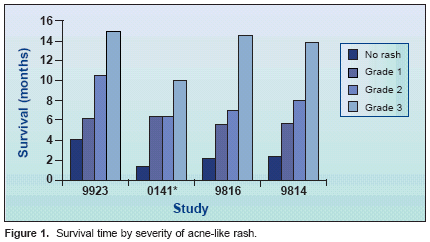With Cetuximab and Erlotinib, Rash Correlates With Survival
This special “annual highlights” supplement to Oncology News International is acompilation of major advances in the management of lung cancer during 2003, asreported in ONI. Guest editor Dr. Roy Herbst comments on the reports includedherein and discusses advances in the clinical management of lung cancer, with afocus on developments in targeted therapy, new combinations, adjuvant therapy,induction therapy, and what to watch for in 2004.
CHICAGO-Separate reviewsof data from multiple phase IItrials with novel agents cetuximab (Erbitux)and erlotinib (OSI-774, Tarceva)have concluded that patients whodeveloped an acne-like rash lived longerthan those who did not, and that patients with more severe rash livedlonger than patients with mild rash(Figure 1).In presenting their analyses at the39th Annual Meeting of the AmericanSociety of Clinical Oncology (ASCO)(abstracts 786 and 817), the investigatorssuggested that rash could be abiomarker for response to HER1/epidermal growth factor receptor inhibitors(HER1/EGFR). Rash also wasidentified as a predictor of response togefitinib (ZD1839, Iressa), a thirdagent that targets EGFR (J ClinOncol21(10):1980-1987, 2003).The big question is whether theobservation will prove clinically useful.Both groups of researchers speculatedthat the optimal dose of HER1/EGFR inhibitors could be linked to anoptimal degree of rash in each patient,but they cautioned that the rash mightbe a surrogate for another factor involvedin the response."It could mean that a strategy forimproving the effectiveness of the drugcould be to dose to a certain level ofrash... in order to escalate to a degreeof side effect that will be commensuratewith a higher degree of activity,"said Leonard B. Saltz, MD, associateattending physician, Memorial Sloan-Kettering Cancer Center.Alternative Hypothesis"An alternative hypothesis wouldbe that patients have particular polymorphismsof the epidermal growthfactor receptor that make them morevulnerable to toxicity and their tumorsmore vulnerable to the attack bythis particular drug," Dr. Saltz continued."We really don't know if thisobservation will have a therapeuticmeaning or not," Dr. Saltz said.Gary M. Clark, PhD, senior directorof biostatistics and data managementof OSI Pharmaceuticals, Inc.,compared the rash to tumor flares experiencedby breast cancer patients treated with tamoxifen in the early1980s. Some women asked to be takenoff the then-new drug because of painand vaginal dryness, but it turned outto be a sign the drug was working, saidDr. Clark, lead investigator of theerlotinib analysis."The question, of course, is can wedo anything about this? Can we takeadvantage of it?" Dr. Clark said. "Is itpossible to increase the dose in somepatients and achieve a better clinicaloutcome?" He said that OSI has alreadystarted a dose-to-rash study.Review of Previous TrialsDr. Saltz and Dr. Clark each mineddata from previously reported phaseII trials. ImClone Systems Incorporated,Somerville, New Jersey, developerof cetuximab with Bristol-MyersSquibb Oncology, participated in thecetuximab study.Dr. Saltz reviewed trials evaluatingcetuximab:
- with irinotecan (CPT-11,Camptosar) in 120 patients with colorectalcancer;
- alone in 57 colorectal cancer patients;
with cisplatin in 79 patients withsquamous cell cancer of the head andneck; and
- with gemcitabine (Gemzar) in41 pancreatic cancer patients.

About 75% of patients developed arash. In all four studies, patients withno rash had the shortest median survival,while patients with grade 3 rashlived longest (see Figure 1). In patientswith pancreatic cancer, for example,the range for length of survival wentfrom 2.3 months with no rash to 13.9months with grade 3 rash.So far the rash has been treatable aswell as controllable with dose adjustment,Dr. Saltz said. He voiced a concern,however, that the finding "impliesa relatively modest therapeuticwindow whereby we're going to haveto accept the skin toxicity to get whatwe want out of the drug."
Relationship to Outcome
Dr. Clark reviewed three erlotinibstudies.
- Among 57 patients with refractorynon-small-cell lung cancer(NSCLC), 75% developed rash.
- Among 115 patients with advancedsquamous cell cancer of thehead and neck, 70% developed rash.
- Among 34 patients with advancedovarian cancer, 82% developed rash.
No patient without a rash respondedto therapy. Pooled data from allthree studies showed median survivalof 44 days without rash, 67 days withgrade 1 rash, and 95 days with grades2/3 rash."I looked at every possible pretreatmentcharacteristic I could find. Some of them correlated with outcomes,but none of them changed the relationshipbetween rash and outcomes,"Dr. Clark said.A coauthor of the erlotinib analysis,Roman Perez-Soler, MD, of MontefioreMedical Center, Albert EinsteinCollege of Medicine, Bronx, NewYork, raised the rash issue at "TargetingCritical Pathways in Oncology," apost-ASCO, industry-sponsored satellitesymposium. Nine studies withseveral hundred patients have showna strong relationship between rash andsurvival with agents targeting HER1/EGFR, according to Dr. Perez-Soler.And there is a consistant trend betweenhigher grades of rash and longersurvival. (Also see the report on Dr.Perez-Soler's presentation at the 10thWorld Conference on Lung Cancer,on pages 23 and 24 of this issue.)"Should we adjust doses to grade1/2 rash?" Dr. Perez-Soler asked rhetorically."We don't have the answertoday; but obviously we should payattention to this."